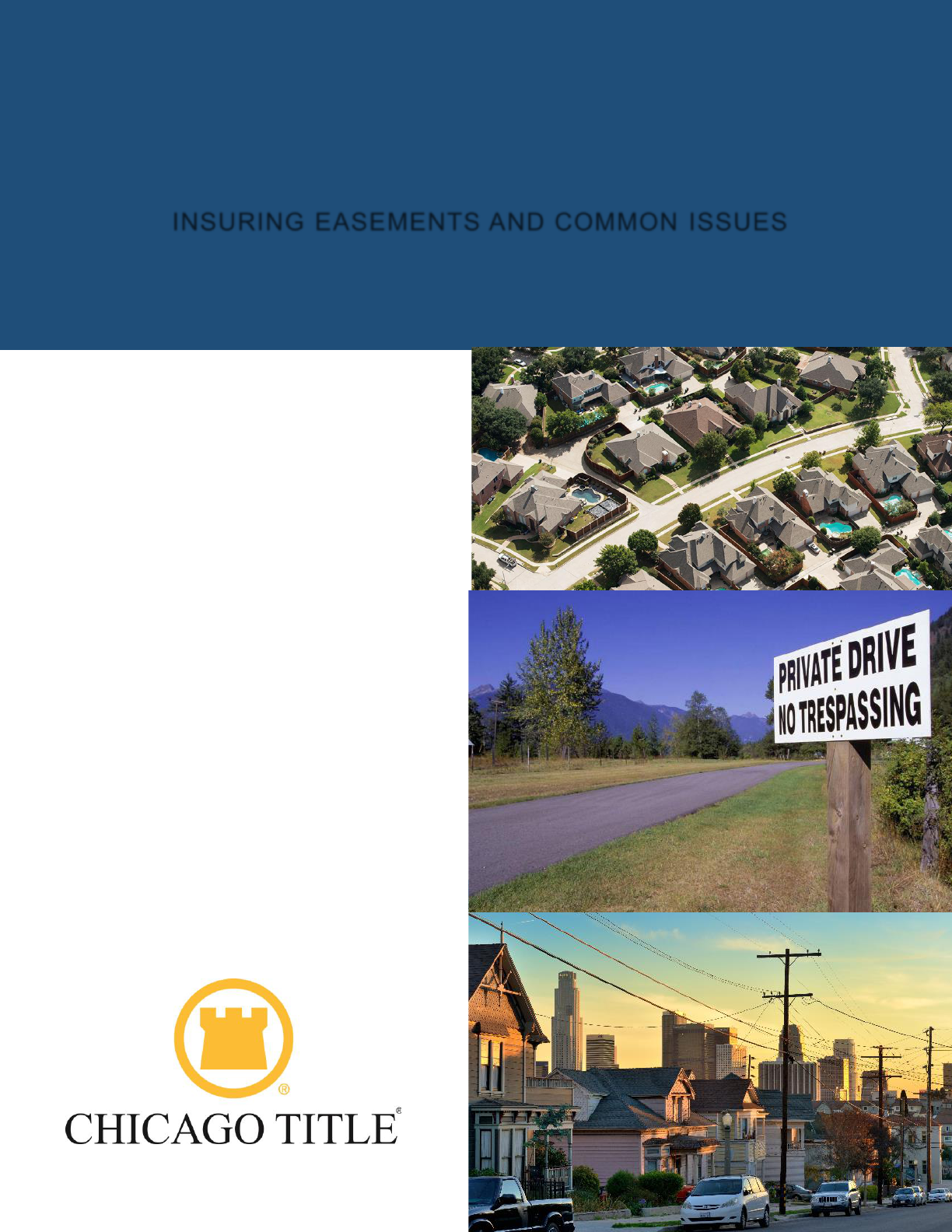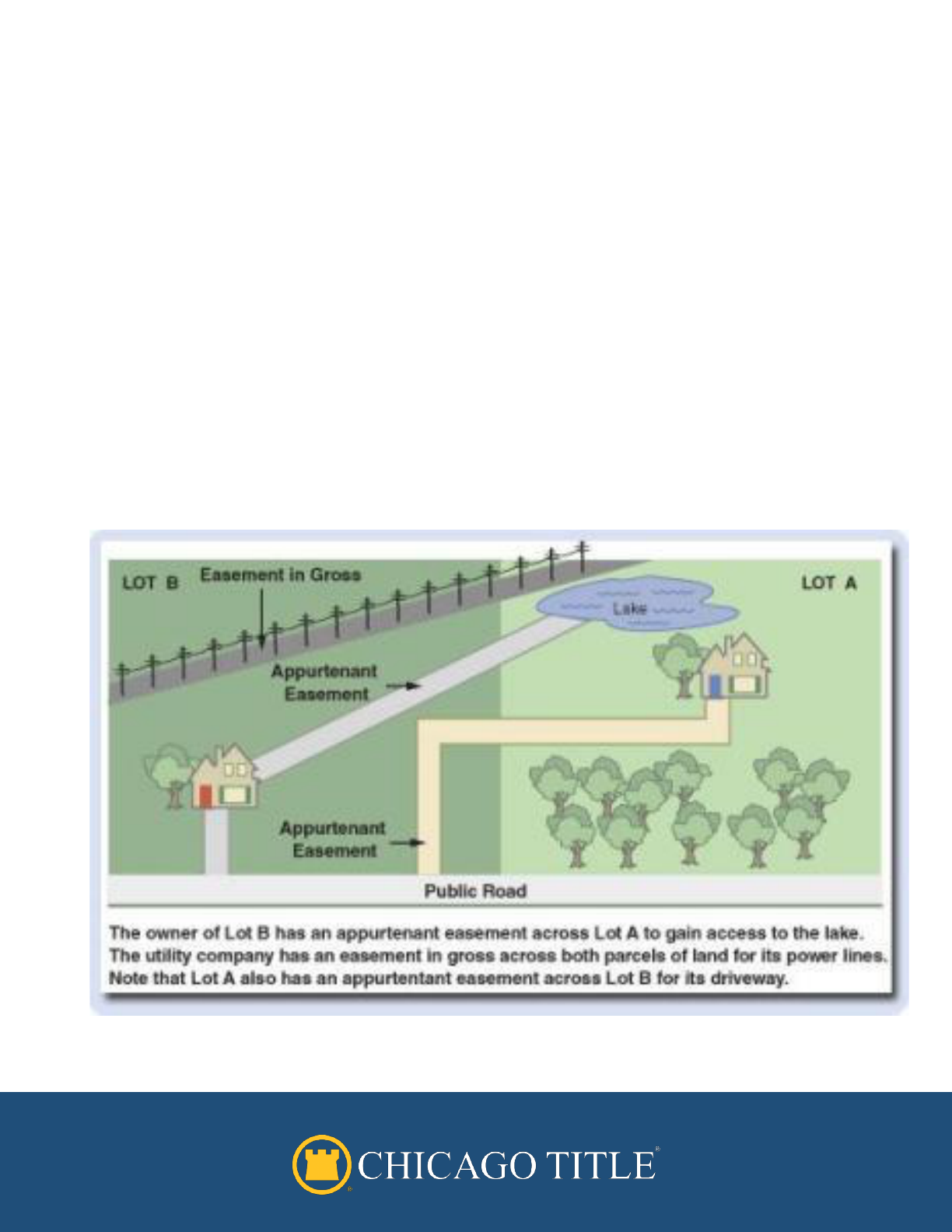
INSURING EASEMENTS AND COMMON ISSUES
Easements . . . Ugh!
Zack P. Marco, Esq.
Underwriting Counsel
Chicago Title Insurance Company
MLTA
2021 Winter
Education Series

Easements Overview
Importance of Easements
Insuring Easements
Easements as shown on the Commitment
Terminating/Extinguishing Easements
Common Issues relating to Easements
Questions?
AGENDA

EASEMENTS
Simply put, an easement is an
interest in real estate that gives one
person the right to use another’s land
for a specified purpose.
Examples:
Private road
Shared driveway
Utility easement
Drainage easement
Walk/bike path
Beach access
Railroad
Spotting Easements:
Survey
GIS/Aerial Maps
Plat/Subdivision/Condo
Commitment/policy
Deed or Instrument
In person

EASEMENTS:
Importance of Easements
Owner’s and Loan Policy insure that the property has legal
access, therefore, in order to provide that coverage, we will
review the title search and maps to determine if the property
abuts a public road or that there is a recorded document
establishing an easement for access.
2006 ALTA Owner’s and 2006 ALTA Loan Policy:
Covered Risk No. 4: No right of access to and from the Land
These provisions refer to legal access, meaning, the Insured has
the legal right to enter the Land.
Legal access does not mean that the Insured has actual physical
access to the land (2013 Homeowner’s Policy does extend
coverage to actual access)
2013 ALTA Homeowner’s Policy:
Covered Risk No. 11: You do not have actual vehicular and
pedestrian access to and from the Land, based upon a legal right.
If the land abuts a public right of way, the Insured will have legal
access; the fact that the public right of way has a guard rail
running across the front of the property and the Insured cannot
drive a car onto the land does not invalidate the
Insured’s right of legal access.
It is evidence of the lack of actual physical access.

EASEMENTS
There are two basic types of easements: (1) Easement
Appurtenant, and (2) Easement in Gross
1. An easement appurtenant serves or benefits one parcel
of land by passing over or burdening another.
2. An easement in gross is granted for the benefit of a
particular person/entity.

EASEMENT
APPURTENANT
The land served or benefitted by an easement appurtenant
is called the “dominant” tenement.
The land burdened by an easement appurtenant is called
the “servient” tenement.
An easement appurtenant that is validly created “runs with
the land” meaning it passes with every subsequent
conveyance of the dominant parcel.
Example of an easement appurtenant is a private driveway.
An easement appurtenant may be created by a separate
instrument (i.e. an Easement Agreement) or be included in
a deed transferring the dominant/benefitted parcel

EASEMENTS IN GROSS:
GOVERNMENT & UTILITY EASEMENTS
An easement in gross is personal in nature; it attaches a
particular right to an individual or entity rather than to the property
itself.
As opposed to easement appurtenant, there is no dominant
parcel.
Most commonly associated with utility companies, municipalities,
and railroads.
Could also be used to grant persons the right to use a path
through the neighbor’s property to reach lake, beach, or hunting
area.
For example, an easement in gross would be used to grant a
utility company the right to enter the property to run necessary
cabling
• The utility company would have the right to access the
property to maintain their equipment and easement area
• The property owner would be prohibited from blocking
the easement area or building on that area
An easement in gross may be assignable if commercial in nature
like an easement for pipelines, telephone lines, or railroads.
Michigan Land Title Standard 14.2

EASEMENTS:
Insuring Easements
As previously discuss, the policies provide a Covered
Risk for “No right of access to and from the Land”.
Note the policy speaks in terms of a right of access
This does not have to be via a specific means, nor
even the most convenient means.
The insured must only have SOME legal right of
access, and to cure an access deficiency under the
policy, we need only supply SOME legal right of
access (i.e. confirm the property abuts a public road)
If the insured wants or needs specific access insured,
affirmative insurance of a specific easement is
required.
If you are relying upon an easement as a basis for
insuring access, it must be “insurable”, even if you
don’t specifically insure it on Schedule A
Let’s talk about how to insure an easement

EASEMENTS:
Insuring Easements
The ownership of an appurtenant easement (one which runs with
the title to the land which it benefits) can be insured in a title
policy that also insures the ownership of the land it benefits.
STEP ONE
Search/examine the chain of title of the servient tenement
(burdened property) back to the time when the easement was
created in order to confirm it was “validly” created.
“Validly” created: all the owners of record of the servient tenement
executed the instrument that created the easement (the deed,
grant of easement, or easement agreement)
Also determine what outstanding interests, if any, could be
superior to the easement (i.e., liens, such as mortgages or taxes,
and other parties whose interests could impact on the ability of
the easement holder to use the easement area).
Make sure the easement was not released or terminated by
merger (discussed more later on).
STEP TWO
Examine the instrument itself; check to see if the parties as
disclosed by the search have effectively bound their interests, and
that the instrument expresses sufficient intent to render the
easement appurtenant to the dominant tenement (vague or non-
locatable easements give rise to much litigation). Check if the
easement is exclusive or non-exclusive.

EASEMENTS:
Insuring Easements
STEP THREE
All real estate taxes, special assessments, mortgages or other
encumbrances that are liens on the servient estate at the date of
the recording of the easement should be shown as exceptions, if
not previously released
Include the easement description in the Insured Legal Description on
Schedule A
Show an exception for the terms and conditions of the document
that created the Insured Easement
Show an exception for the rights of others in that easement; unless
stated otherwise, an easement is presumed to be nonexclusive
INSURING A NEWLY CREATED EASEMENT
Determine who needs to grant the easement and execute the
instrument, and include a requirement to record an instrument
creating the easement
The easement could be created in the deed to a purchaser as a
reservation or a grant of easement; it may also be created by an
easement agreement between the parties
If there is an open mortgage on the burdened parcel, require that the
mortgagee consents to the easement; important in case of a
foreclosure
Review taxes and assessments to make sure no tax forfeiture

EASEMENTS:
Showing Easements on Commitment
Raise an exception for any easement which burdens
the land, that is found in the Public Records (i.e.
recorded document), depicted on a survey, or shown
on a plat map.
Ex. “Right(s) of Way and/or Easement(s) and rights
incidental thereto, as granted to Consumers Energy in
a document recorded as recording no. Liber 1, Page
1.”
If an easement benefits the land, and it is “insurable”,
then it may included in the Legal Description on
Schedule A – “together with an easement . . .”
However, Schedule B must include (1) an exception for
the terms and conditions of the creating instrument,
and (2) an exception for the rights of others in the
easement described in Schedule A
Ex. “Terms, conditions and provisions of a certain
easement agreement recorded in Liber 1, Page 1.”
Ex. “Rights of others in and to the use of the
easement(s) as described in Schedule A.”

EASEMENTS:
Ways to Terminate
Mutual Agreement: Between all parties that benefit
from the easement at the time of release
Expiration of Term/Purpose: If an easement states
an expiration date, or contains a provision that it will
terminate upon the occurrence of a future event or
when the purpose ends
Merger: When title to dominant estate and servient
estate become held by same party (even if the
property is split again, easement is extinguished)
Foreclosure: Foreclosure of an interest that has
priority over the easement (i.e., mortgage, lien, land
contract, etc.). Interests recorded before the
easement
Abandonment: Lack of use is NOT enough. Intent of
parties must be proven. Do not rely upon claims of
abandonment to remove an easement exception.
Contact your underwriter; they typically require a court
order

EASEMENTS:
Common Issues
Landlocked: After reviewing the chain of title, survey, maps/GIS,
the property does not abut or public road or does not have a
means of access
Raise a requirement to establish and record an easement
Insuring a split: If you are insuring a land division, make sure the
land split does not result in a landlocked parcel, or if it does, make
sure there will be an easement established
Customer/Agent states there is access, but no easement is
found: (1) an easement was not validly created, or (2) it is an
implied easement
(1) Not an insurable easement: the easement was not
“validly” created, meaning, the correct parties did not
convey/grant an easement, did not sign the easement
document, or one was never recorded
(2) Implied easement: there is no recorded document
establishing an easement, but the agent/customer states
there is a road or other means of access
An implied easement may be created by operation of law,
however, a court order is required to insure these:
Easement by necessity (landlocked parcel)
Easement by prescription (15 years)

EASEMENTS:
Common Issues
Merger of Title: the access easement was extinguished when an
owner of the benefitted parcel became fee title owner of the
burdened parcel; one cannot hold an easement over his/her own
property
Easement could be revived with a subsequent transfer and
grant of easement or reservation
Easement missing in the chain of title: When the chain of title
shows an access easement but then it is left off some other
deeds in the chain; as long as it was validly created, it may be
insurable so long there is no evidence it was terminated/released
MLTS 14.1: An easement appurtenant is included in the
conveyance of the dominant estate [benefitted parcel] in the
absence of express language to the contrary
Insuring Homeowner’s Policy: When purporting to issue the
Homeowner’s Policy, keep in mind the additional coverage and
make sure the property has actual vehicular and pedestrian
access to and from it
Overburdening Easements: The concept of overburdening an
easement relates to the overuse of a specific grant of easement;
the scope of an easement encompasses only those burdens on
the servient estate that were contemplated by the parties at the
time the easement was created
Keep this in mind when insuring an easement and the
transaction involves construction or new development; could
give rise to future dispute or litigation

THANK YOU! QUESTIONS?
